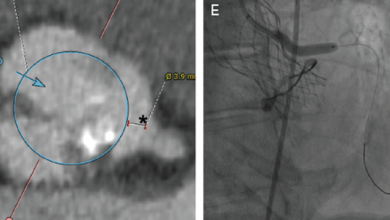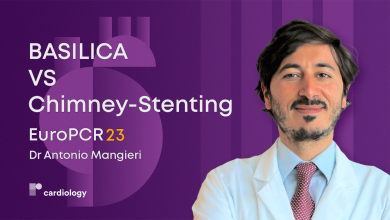Search results
PROMOTED
Author(s):
Nicolas M Van Mieghem
,
Kendra J Grubb
,
David Hildick-Smith
,
et al
Start date:
Mar 26, 2024
Author(s):
Bahaeddin Shabaneh
,
Neil Strickman
,
Zvonimir Krajcer
Added:
3 years ago
Carotid stenting has been introduced for the treatment of carotid artery stenosis as a potentially less invasive therapy than carotid endarterectomy, because carotid stenting does not require general anaesthesia and does not lead to local surgical complications. Despite major technical progress in decreasing the risk of embolisation, this risk continues to be a hurdle in the acceptance of carotid…
View more
Author(s):
Uwe Schwarzwälder
,
Thomas Zeller
Added:
3 years ago
The first renal artery balloon angioplasties were performed by Felix Mahler in Berne and Andreas Grüntzig in Zurich in 1977 using self-made, bulky, coaxial balloon catheters.1,2 Until the beginning of the 1990s, balloon angioplasty was the only method of percutaneous treatment of renal artery stenosis (RAS) with satisfying acute and long-term results for angioplasty of stenoses caused by…
View more
Author(s):
Jacques Théron
,
Leopoldo Guimaraens
,
Alfredo Casasco
,
et al
Added:
3 years ago
The use of cerebral protection during carotid stenting is being less and less contested. The protection systems currently available present a certain number of inconveniences.
The new system that the authors propose is an evolution of the cerebral protection concept by temporary occlusion of the distal internal carotid.1-3 Experience with several hundred endovascular treatments of the carotid…
View more
Chimney Stenting During TAVI
Author(s):
Liesbeth Rosseel
,
Michael Rosseel
,
Brian G Hynes
,
et al
Added:
3 years ago
Article
Author(s):
William R Colyer Jr
,
Christopher J Cooper
Added:
3 years ago
Atherosclerotic renal artery stentosis (RAS) is a frequently recognised cause of secondary hypertension and chronic kidney disease.1–4 Revascularisation of RAS with angioplasty and stenting is often performed with the goals of improved blood pressure control and preserving or improving renal function.5 However, renal artery stenting is sometimes associated with acute worsening of renal function.6…
View more
Author(s):
Rick Volleberg
,
Stijn van den Oord
,
Robert-Jan van Geuns
Added:
1 year ago
Author(s):
Fabrizio Fanelli
,
Emanuele Boatta
,
Pierleone Lucatelli
,
et al
Added:
3 years ago
Stroke is the third leading cause of death and permanent disability in the US and Europe. It is estimated that there are over 700,000 new cases of stroke each year in the US, of which 20–30% are thought to be secondary to carotid thromboembolic disease.1 In the last few years, carotid artery stenting (CAS) has significantly expanded as an alternative treatment to the conventional surgical carotid…
View more
Author(s):
Johan Formgren
Added:
3 years ago
Since the publication of the Endarterectomy versus Angioplasty in Patients with Symptomatic Severe Carotid Stenosis (EVA-3S) and Stent-supported Percutaneous Angioplasty of the Carotid Artery versus Endarterectomy (SPACE) studies, doubts have been raised regarding the safety of carotid artery stenting (CAS) as an alternative carotid intervention to carotid endarterectomy (CEA). A recent meta…
View more
Author(s):
Antonio Mangieri
Added:
11 months ago
EuroPCR 23 – Dr Antonio Mangieri (Humanitas Research Hospital, IT) joins us to discuss the data from a study that compared BASILICA and Chimney stenting in high-risk TAVR patients.
The study found similar efficacy and outcomes between BASILICA and Chimney stenting at one year. BASILICA may reduce complications associated with ostial stenting and does not increase the risk of stroke with cerebral…
View more













